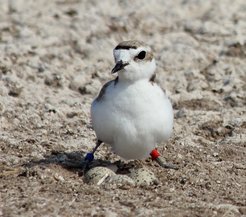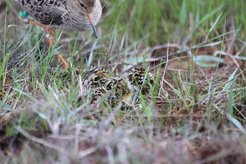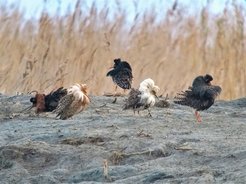Wading birds: shorebirds with unusual social structures
Waders display fascinating behaviour patterns, but are also exemplary for the loss of biodiversity
Waders like wet conditions. They look for insects and other creepy-crawlies in the damp earth. Some species, such as the Mexican snowy plover or the ruff have developed fascinating behavioural patterns. Clemens Küpper and his working group at the Max Planck Institute for Ornithology in Seewiesen is conducting long-terms studies of the social behaviour of these birds. Here, the issue of biodiversity is central, since like many groups of bird species, the numbers of wading birds are in dramatic decline.

The snowy plovers don't exactly embody the classic image of bird family life. The eggs, for example, are incubated by male as well as female birds. Once the chicks have hatched, the mother usually goes looking for a new partner while the father is left to rear the chicks by himself.
Sometimes, though, the female remains with the family – at least at first. “For her, the chances of survival of the brood are the key factor. If the father is able to rear them on his own, she leaves the nest. If the situation looks pretty hopeless, she also disappears off into the sunset,” Clemens Küpper explains.
What is the cause of this unusual distribution of roles in the animal world? Together with his team, Clemens Küpper is conducting a long-term study on the social behaviour of the birds, which live along the coasts of America. "The key is the gender ratio. There are more males among the snowy plovers than there are females. Females can therefore allow themselves the luxury of leaving the rearing of their chicks to their partner, and to go and look for another bird to mate with,” he explains. If male and female chicks are roughly evenly spread in the oviposition, the relationship changes in favour of the males. However, researchers still don't know why more female than male chicks die.
Under threat on many fronts
Like most other wading birds, the snowy plover is under threat. Prawn farms, an increase in building along the coastline and the popularity of sandy beaches, the preferred breeding grounds of the birds, are reducing the size of their habitat to an increasing extent. “Most wading birds are migratory – in other words, they use several habitats. If the living conditions in the breeding and overwintering grounds deteriorate, the birds suffer multiple setbacks at once,” Küpper explains.
In Germany, intensive farming is creating more problems for wading birds than anything else. For example, numbers of lapwings – which until just a few years ago were a common sight in German fields – have declined by 90 percent in some areas. Curlews are also on the brink of extinction in some places. “Nowadays, many nests get crushed by machinery when fields are mown too early and too frequently. If only the first mowing could be put back by three or four weeks, it would make a big difference for the protection of wading birds and grassland bird species.”
Fighting arenas
And the “waders”, as they are known in specialist circles, have even more to offer. The ruff, for example, has one of the most unusual social structures in the bird world.

The males compete in real arenas for the favour of the females. The strongest fighter has a threefold chance of procreating. However, only 20 percent of the males have access to these competition grounds; the others fly from one arena to the next and try and gain entry.
The male ruffs can be divided into three personality types: as well as the fighters, there are males without decorative feathers with female-like plumage, who are not aggressive and who also do not perform courtship displays to gain the females’ favour. “They look like females and behave like females,” Küpper explains. That enables them to mate with the females undetected. This change in behaviour is caused by a chromosomal accident, which leads to a permanent change in the bird’s genetic makeup. Clearly the behaviour has been so successful that this mutation has not died out – even though it is deadly if a bird has two copies of it.
Successful thanks to an unlikely wingman

Another genetic mutation can be observed among so-called “satellites”. They perform courtship rituals for the females, but show almost no aggression. “Fighters and satellites are often seen together. This combination appears to be highly attractive to the females, since such duos are extremely successful. In such cases, the satellite only gets to mate with the female when his partner is busy defending against competitors.”
Even so, this bizarre behaviour has not protected the ruff from becoming increasingly rare. In Finland, where Küpper and his team study the ruffs in the wild, they are also threatened by intensive farming. The bird, which actually benefits when fields are grazed by cattle, has almost no chance of incubating its eggs or rearing its young when there are too many cattle. In Germany, too, the birds are only able to survive when extensive agricultural methods are used. “Initiatives such as the referendum on species diversity in Bavaria and other federal states give us hope that in the future, biodiversity and agriculture will no longer be at loggerheads. Then we will see a return of the ruff to Germany,” says Küpper.














